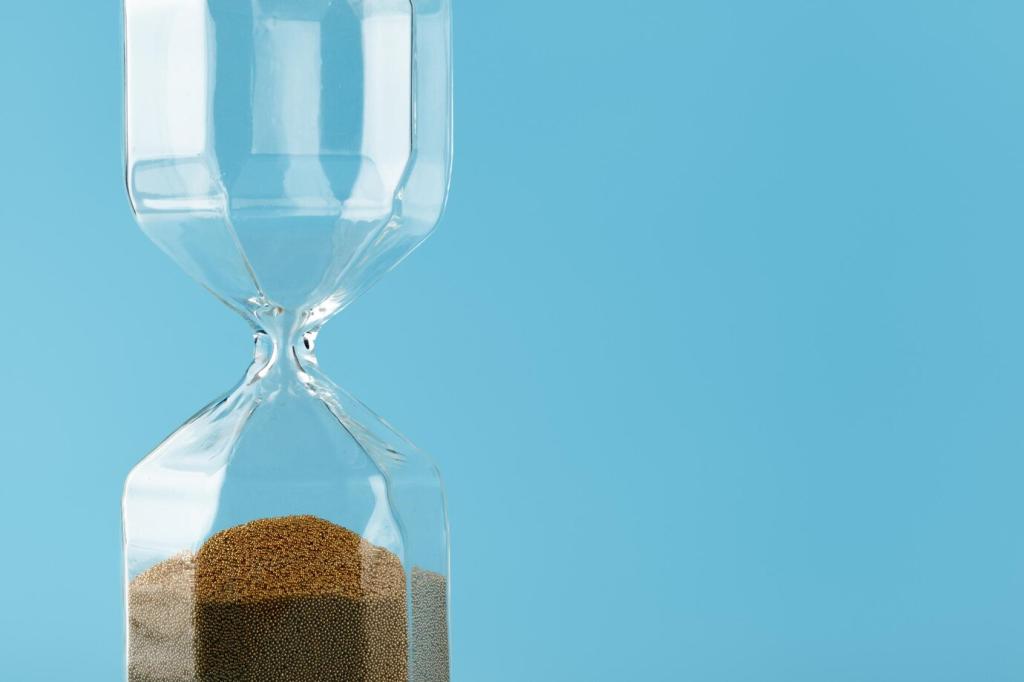
Master Your Minutes: Effective Goal Setting for Time Management
Chosen theme: Effective Goal Setting for Time Management. Let’s turn time into a trusted ally, using clear goals that fit real calendars and real lives. Expect practical techniques, stories, and prompts that help you commit, focus, review, and finish what matters. Subscribe for weekly goal-mapping prompts and share your top priority for the week in the comments.
From “Be Productive” to “Finish Draft by Friday 3 PM”
Specific goals reduce decision fatigue and make time estimates concrete. Instead of chasing a feeling, define a deliverable, deadline, and context. Research on goal-setting shows specificity boosts performance by giving your brain a target. Try it today: write three crystal-clear outcomes, schedule them, and tell us one in the comments to stay accountable.
Measurable Milestones Motivate Momentum
Progress you can see is progress you will continue. Break a goal into measurable checkpoints, like sections written, calls completed, or slides finalized. Each small checkpoint creates a micro-win, feeding motivation. Track them visibly on a simple checklist or Kanban board and report your milestone tally at week’s end to reinforce momentum.
Reality-Checked Time Frames
Avoid the planning fallacy by doubling initial estimates for new or complex tasks. Add buffer blocks for context switching and recovery. Label deadlines as soft or hard so you can triage honestly. This reality check prevents cascading delays and protects your calendar from optimistic guesswork. Comment with one task you’re recalibrating right now.
SMART, But Built for Real Life
Specific and Significant
Make goals specific, but also significant to your season of life. If a goal is tied to a personal why, it competes better against distractions. Write one sentence that links your outcome to a meaningful reason. Post it where you plan. When purpose is visible, time flows toward what matters most instead of what shouts loudest.
Measurable and Meaningful Metrics
Choose metrics that reflect true progress, not vanity. Minutes of deep work, drafts completed, or bugs fixed beat abstract “hours worked.” Tie metrics to outcomes that customers or future-you would recognize. Share your chosen metric this week and track it daily; a simple tally can expose patterns and reveal where to fine-tune focus.
Attainable, Relevant, and Time-Bound
Stretch yourself without snapping your schedule. Test attainability by fitting the work into your calendar first, then committing. Keep goals relevant by aligning them with quarterly priorities, not passing trends. Time-bound means clear starts, finishes, and review points. Put your mid-point check-in on the calendar now to course-correct before it’s too late.
Time Blocking Around Outcomes
Translate Goals into Calendar Blocks
For every goal, create blocks labeled with a specific outcome, not just “work.” Example: “Write methods section, 90 minutes.” This label narrows attention and pre-decides scope. Sequence blocks by dependency, then add buffer. At day’s end, audit which blocks held and why. Tell us which label helped you focus most powerfully today.
One Focus Block, One Outcome
Multitasking leaks time. Dedicate each block to a single outcome and remove competing apps. Use a visible timer to anchor attention and signal urgency. If interruptions occur, capture them in a separate list without breaking the block. You will finish faster and feel calmer. Share one distraction you will quarantine during your next focus block.
Schedule by Energy, Not Just Time
Match demanding tasks to peak energy hours and reserve low-energy slots for admin. A quick daily energy scan informs smarter scheduling. Over a week, you’ll notice patterns that make planning easier. Place your most important goal where your brain is strongest, not where your calendar happens to be empty. Comment your peak hour.

Begin with a two-minute action that commits you to the session: open the file, write the outline header, or draft the first email line. This tiny start overcomes inertia and often snowballs into deep work. It’s easier to continue than to start. Share your two-minute launch ritual to inspire someone else’s first step today.

Attach a goal action to a strong daily anchor: after coffee, before lunch, or right after a meeting. Habit stacking removes the need to remember, because the routine itself becomes the cue. Keep the first stacked action small and consistent. What routine will you use as your anchor this week? Tell us your plan below.

Tie immediate, ethical rewards to specific actions, not just outcomes. Celebrate completing a focus block with a short walk or music break. Visible streaks and checkmarks trigger dopamine that reinforces the habit loop. Keep rewards aligned with health and values so consistency remains sustainable. Post your favorite micro-reward to give the community ideas.



Review Rituals That Compound
Spend fifteen minutes every Friday answering three questions: what moved the goal forward, what blocked progress, and what I’ll try next week. A reader named Maya cut her project cycle time by a third using this ritual. Try it for two weeks and report back with one surprising pattern you discovered about your time.
Review Rituals That Compound
Each morning, choose three goal-linked tasks and assign time estimates. Then place them on your calendar, not just on a list. Estimating forces clarity and teaches accuracy over time. If you overrun, note the cause and adjust tomorrow. Post your Top Three today to encourage someone else to choose theirs and commit.
Review Rituals That Compound
Write down one win per day related to your goal, however small. Share your highlights weekly with a friend or the community. Recognition cements identity: you are someone who follows through. Over months, these notes become a motivating progress archive. Comment one win right now—even a tiny one—to keep the streak alive.



